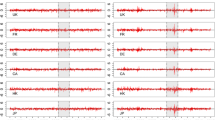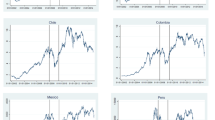Abstract
This paper presents three tests of contagion of the US subprime crisis to the European stock markets of the NYSE Euronext group. Copula models are used to analyse dependence structures between the US and the other stock markets in the sample, in the pre-crisis and in the subprime crisis periods. The first test assesses the existence of contagion on the relevant stock markets’ indices, the second checks the homogeneity of contagion intensities, and the third compares contagion in financial and in industrial sectors’ indices. Results suggest that contagion exists, and is equally felt, in most stock markets and that investors anticipated a spreading of the financial crisis to the indices of industrial sectors, long before such dissemination was observable in the real economy.





Similar content being viewed by others
Notes
NYSE Euronext is a US holding company, created in 2007 by the combination of NYSE Group, Inc. and Euronext N.V. It operates six stock exchanges in seven countries and eight derivatives exchanges. In Europe, NYSE Euronext comprises the stock exchanges of Paris, Amsterdam, Brussels and Lisbon.
Forbes and Rigobon (2001, p. 43) refer that analyses of financial contagion are of ‘critical importance in: portfolio investment strategy; justifying multilateral intervention; and understanding how shocks are propagated internationally’. From this perspective, assessing whether contagion exists and if contagion homogeneity varies across countries may also be of interest to justify distinct levels of intervention and attention on the part of the relevant authorities, following the subprime crisis.
A thorough survey of such theoretical and empirical literature is provided by Pericoli and Sbracia (2003).
See the development in Nelsen (2006).
The specific functional forms of these copulas may be found in Trivedi and Zimmer (2005).
Ravn and Uhlig (2002) suggested the use of the following equation to adjust the Hodrick–Prescott’s parameter (λ) to the frequency of the data: λ = s n*1,600, where s is related to the frequency of the data (s = 1/4 for annual data, s = 3 for monthly data, and s = 90 for daily data) and n is close to 4. Other authors have suggested alternative values for n. For instance, Backus and Kehoe (1992) used n = 2 and Correia et al. (1992) used n = 1. In our case (daily data), λ would be 104.976.000.000 if n = 4, 12.960.000 if n = 2, and 144.000 if n = 1. Since our objective was simply to get a good visual perception of the series’ trends, we used λ = 1.000.000. However, the choice of λ has no implications for the tests performed ahead.
On 17 August 2007, the Fed unexpectedly cut the reference interest rate in 50 b.p. which appears to have motivated a generalized increase in stock exchange indices. On 28 November 2008, the vice-chairman of the Fed made public comments which, according to the Reuters, generated expectations of future cuts of the reference rate. On 1 April 2008, the Financial Times reported that monetary policy actions to combat the financial crisis were discussed by central banks and governmental authorities at the Rome’s Financial Stability Forum.
The publication of quarterly reports by major financial institutions, revealing results above expectations, promoted increases in stock exchange indices (Reuters). Examples were Goldman and Sachs and Lehman Brothers, on 18 March 2008, Citigroup (though with news of negative results), on 18 April 2008, and JP Morgan Chase, on 16 April 2008.
Rank correlation coefficients from distinct copulas are directly comparable and may be used to assess dependence, just like the copulas’ global dependence parameters. Following Eq. 4, for the case of the Gumbel copula, the Kendall’s τ is expressed as a function of that copula’s global dependence parameter, \(\theta :\;\tau =1-\frac{1}{\theta };\theta \in \left[ {1,\infty } \right)\). For the Clayton copula, the relation between the τ and the θ is: \(\tau =\frac{\theta }{\theta +2};\theta \ge 0\). It is possible to convert each copula’s global dependence parameter into rank correlation measures, which allow direct comparisons of global dependence between variables. However, if the interest is not on global, but rather on local dependence, the copulas also allow such analysis. One possibility is to extract the asymptotic tail coefficients from each copula, using Eqs. 5 and 6, to compare asymptotic dependence between variables (this cannot be done using rank correlation coefficients). Flexibility is thus one additional advantage of using copulas in tests of financial contagion, or in other contexts where the understanding of the links between financial variables is important.
References
Aas K, Czado C, Frigessi A, Bakken H (2009) Pair-copula construction of multiple dependence. Insur Math Econ 44:170–181
Ang A, Bekaert G (2002) International asset allocation with regime shifts. Rev Financ Stud 15:1137–1187
Ang A, Chen J (2002) Asymmetric correlations of equity portfolios. J Financ Econ 63:443–494
Backus D, Kehoe P (1992) International evidence on the historical properties of business cycles. Am Econ Rev 82:864–888
Bae K, Karolyi G, Stulz R (2003) A new approach to measuring financial contagion. Rev Financ Stud 16:717–763
Baig T, Goldfajn I (1998) Financial market contagion in the Asian crisis. IMF Working Paper 98/155
Calvo S, Reinhart C (1996) Capital flows to Latin America: is there evidence of contagion effects? In: Calvo G, Goldstein M, Hochreiter E (eds) Private capital flows to emerging markets after the Mexican crisis. Institute for International Economics, Washington
Chan-Lau J, Mathieson D, Yao J (2004) Extreme contagion in equity markets. IMF Staff Pap 51:386–408
Clayton D (1978) A model for association in bivariate life tables and its application in epidemiological studies of familial tendency in chronic disease incidence. Biometrika 65:141–151
Correia I, Neves J, Rebelo S (1992) Business cycles from 1850–1950: new facts about old data. Eur Econ Rev 36:459–467
Costinot A, Roncalli T, Teïletche J (2000) Revisiting the dependence between financial markets with copulas. http://ssrn.com/abstract=1032535
Dungey M, Fry R, González-Hermosillo B, Martin V, Tang C (2008) Are financial crisis alike? In: International workshop on contagion and financial stability. Paris, 30 May. http://www.banque-france.fr/gb/publications/seminaires/articles_presentes_300508.htm. Accessed 25 June 2008
Embrechts P, Lindskog F, McNeil A (2003) Modelling dependence with copulas and applications to risk management. In: Rachev S (ed) Handbook of heavy tailed distributions in finance. Elsevier, Amsterdam, pp 331–385
Favero C, Giavazzi F (2002) Is the international propagation of financial shocks non-linear? Evidence from the ERM. J Int Econ 57:231–246
Forbes K, Rigobon R (2001) Measuring contagion: conceptual and empirical issues. In: Claessens S, Forbes K (eds) International financial contagion. Kluwer, Norwell
Forbes K, Rigobon R (2002) No contagion, only interdependence: measuring stock market comovements. J Finance 57:2223–2261
Frank M (1979) On the simultaneous associativity of F(x,y) and x + y − F(x,y). Aequ Math 19:194–226
Fry R, Martin V, Tang C (2008) A new class of tests of contagion with applications. In: International workshop on contagion and financial stability. Paris, 30 May. http://www.banque-france.fr/gb/publications/seminaires/articles_presentes_300508.htm. Accessed 25 June 2008
Gumbel E (1960) Distributions des Valeurs Extremes en Plusieurs Dimensions. Pub Inst Stat Univ Paris 9:171–173
Hu L (2006) Dependence patterns across financial markets: a mixed copula approach. Appl Financ Econ 16:717–729
Idier J (2008) Long term vs. short term transmission in stock markets: the use of Markov–switching multifractal models. In: International workshop on contagion and financial stability. Paris, 30 May. http://www.banque-france.fr/gb/publications/seminaires/articles_presentes_300508.htm. Accessed 25 June 2008
Joe H (1997) Multivariate models and dependence concepts. Monographs on statistics and applied probability, vol 73. Chapman & Hall, London
Kole E, Koedijk K, Verbeek M (2007) Selecting copulas for risk management. J Bank Financ 31:2405–2423
Krugman P (2009) O Regresso da Economia da Depressão e a Crise Actual, Editora Presença
Lee L (1983) Generalized econometric models with selectivity. Econometrica 51:507–512
Longin F, Solnik B (1995) Is the correlation in international equity returns constant: 1960–1990? J Int Money Financ 14:3–26
Longin F, Solnik B (2001) Extreme correlation of international equity markets. J Finance 56:649–676
McLeish D, Small C (1988) The theory and applications of statistical inference functions. Lecture Notes in Statistics, 44. Springer, New York
Nelsen R (2006) An introduction to copulas. Springer, New York
Pericoli M, Sbracia M (2003) A primer on financial contagion. J Econ Surv 17:571–608
Ramchand L, Susmel R (1998) Volatility and cross correlation across major stock markets. J Empir Finance 5:397–416
Ravn M, Uhlig H (2002) On adjusting the Hodrick–Prescott filter for the frequency of observations. Rev Econ Stat 84:371–376
Rodriguez J (2007) Measuring financial contagion: a copula approach. J Empir Finance 14:401–423
Sarabia J, Gómez-Déniz E (2008) Construction of multivariate distributions: a review of some recent results. Stat Operat Res Trans 32:4–35
Schmidt T (2006) Coping with copulas. In: Rank J (ed) Copulas: from theory to application in finance. Risk Books, London, pp 3–34
Sklar A (1959) Fonctions de repartition à n dimensions et leurs marges. Publications de l’Institute de Statistique de l’Université de Paris 8:229–231
Trivedi P, Zimmer D (2005) Copula modelling: an introduction for practitioners. Found Trend Econmts 1:1–111
Acknowledgement
Isabel Vieira gratefully acknowledges partial financial support from FCT, program POCTI.
Author information
Authors and Affiliations
Corresponding author
Additional information
The views expressed in this paper are those of the authors and do not necessarily represent those of the hosting institutions. Comments from three anonymous referees are much appreciated.
About this article
Cite this article
Horta, P., Mendes, C. & Vieira, I. Contagion effects of the subprime crisis in the European NYSE Euronext markets. Port Econ J 9, 115–140 (2010). https://doi.org/10.1007/s10258-010-0056-6
Received:
Accepted:
Published:
Issue Date:
DOI: https://doi.org/10.1007/s10258-010-0056-6




